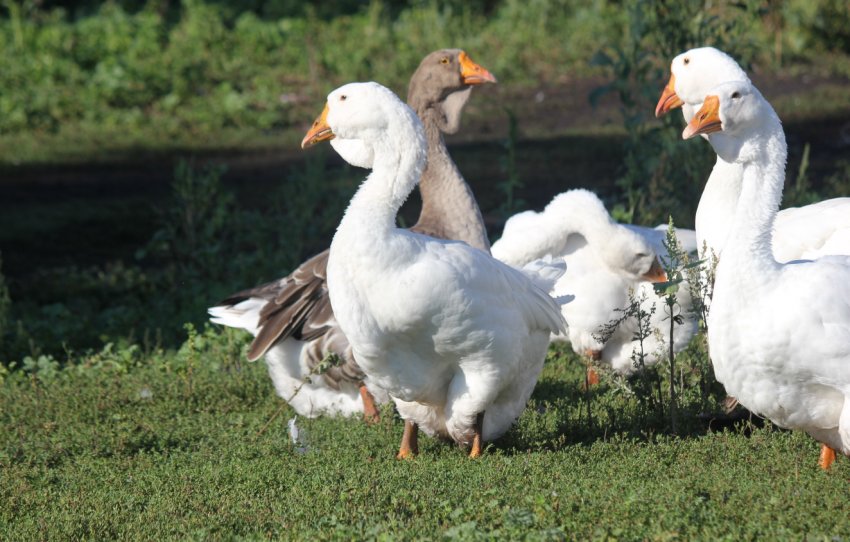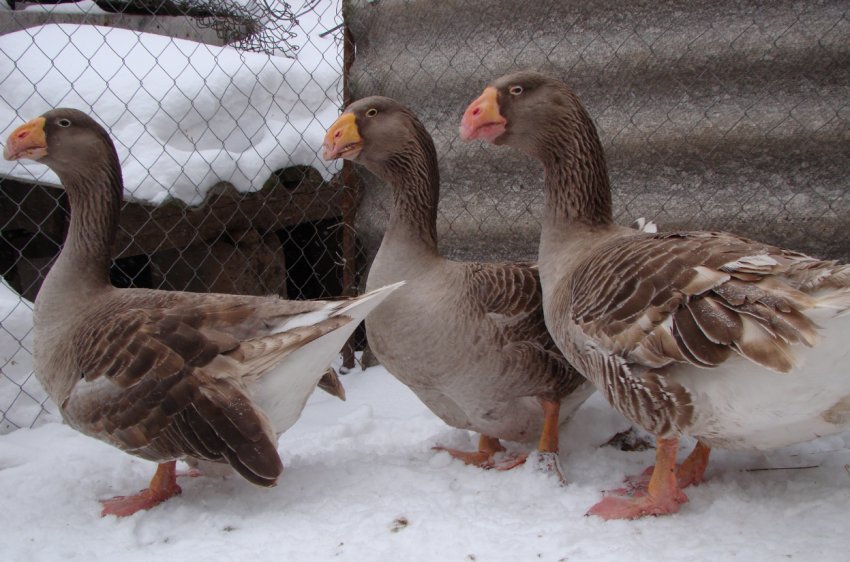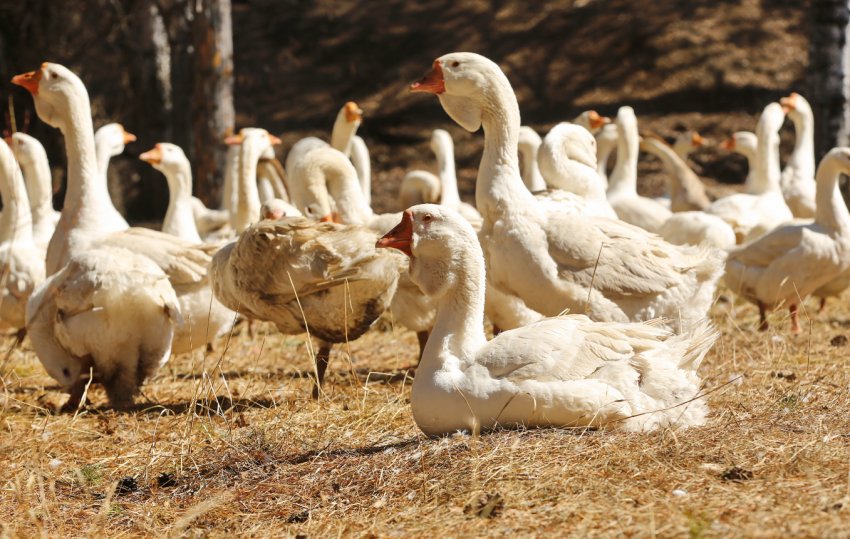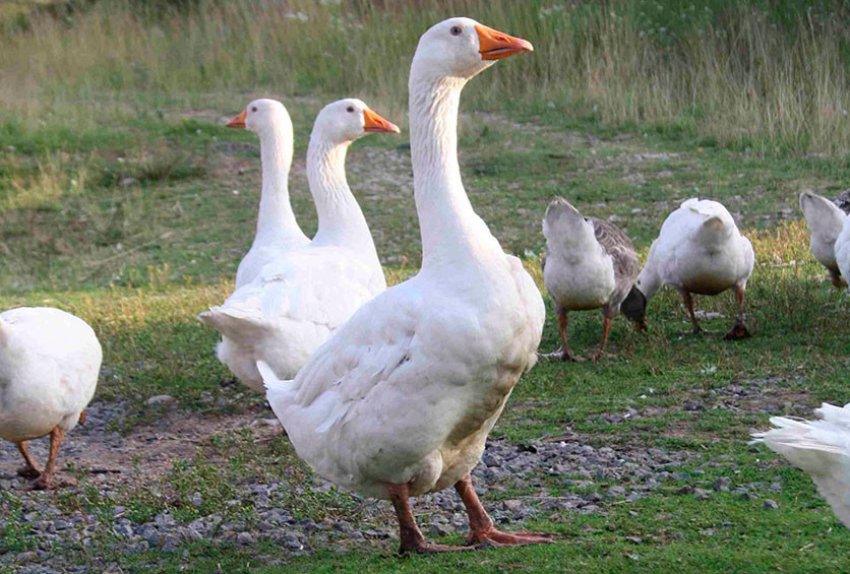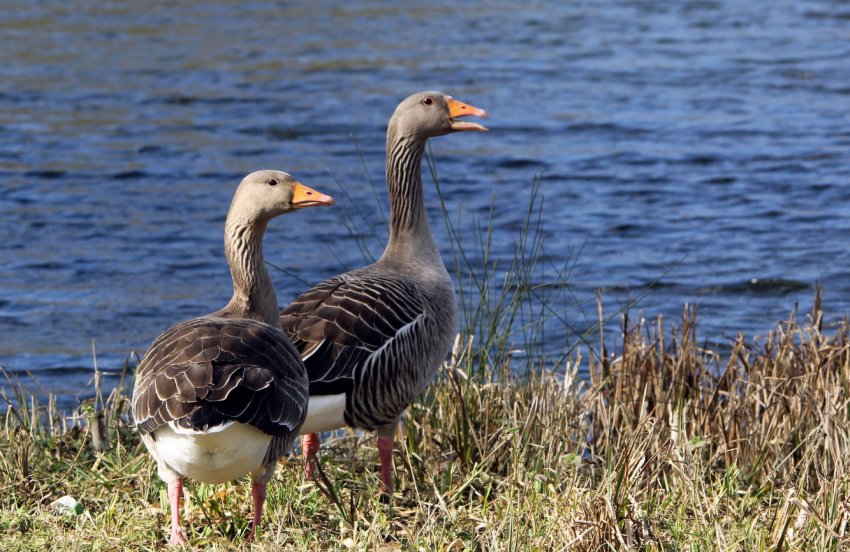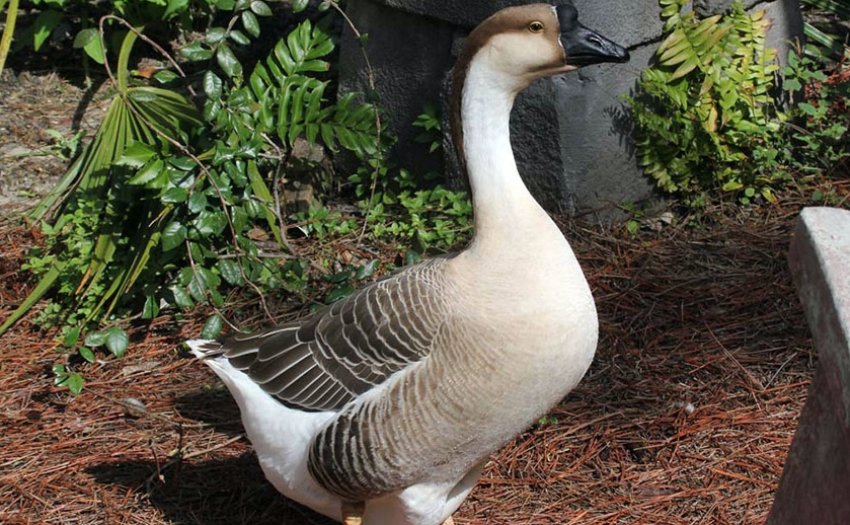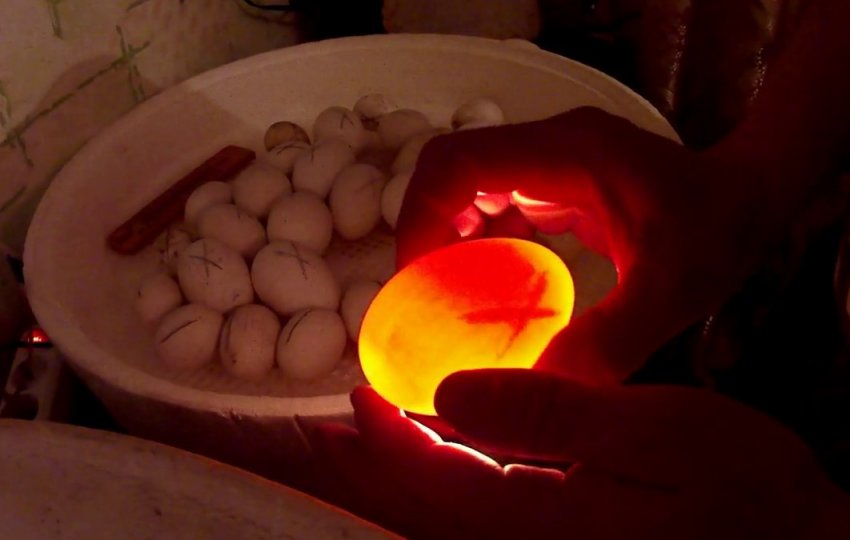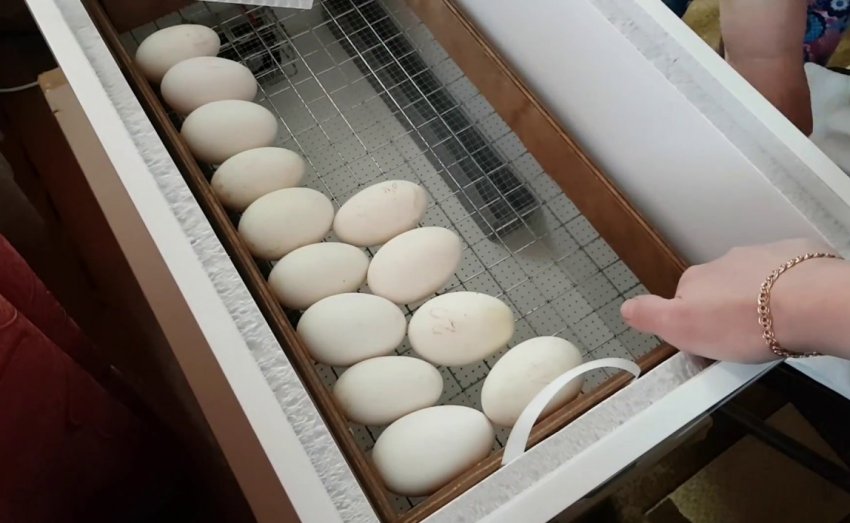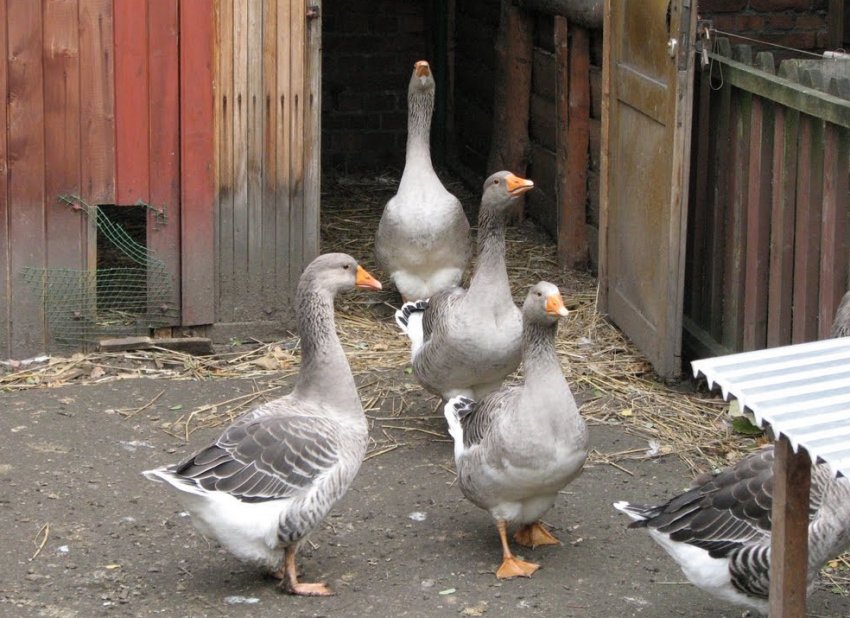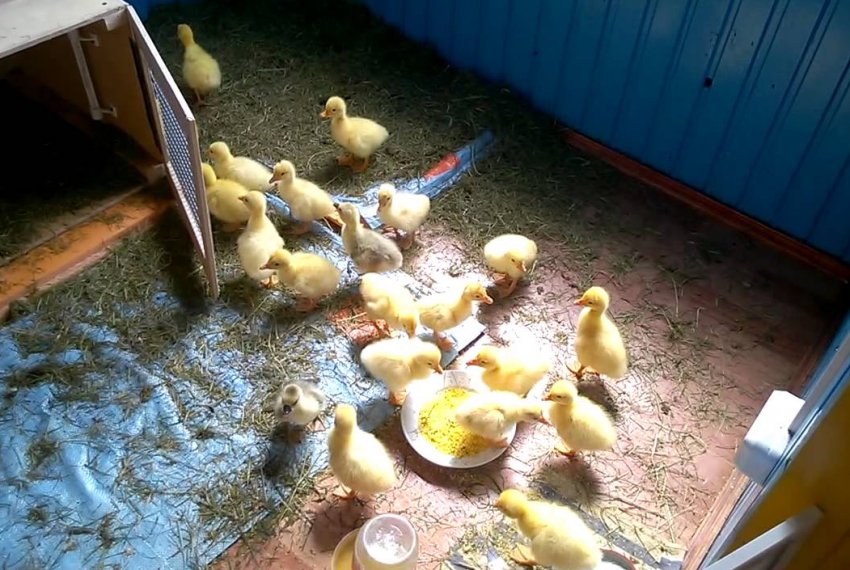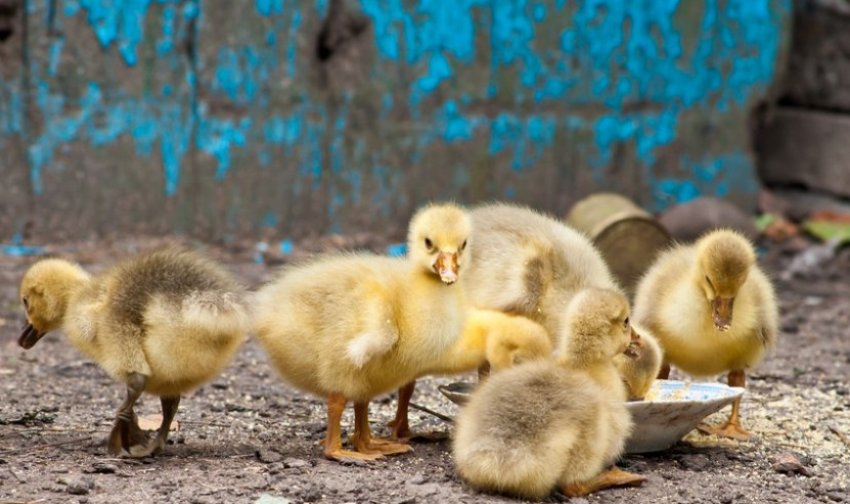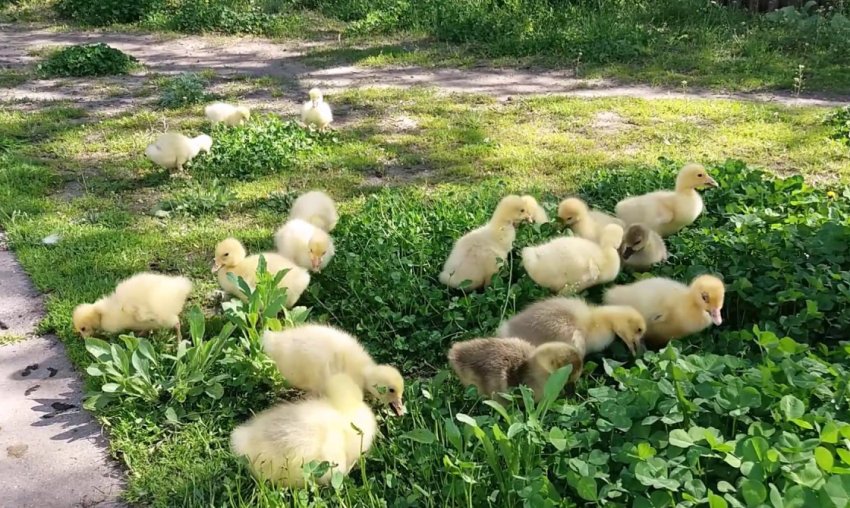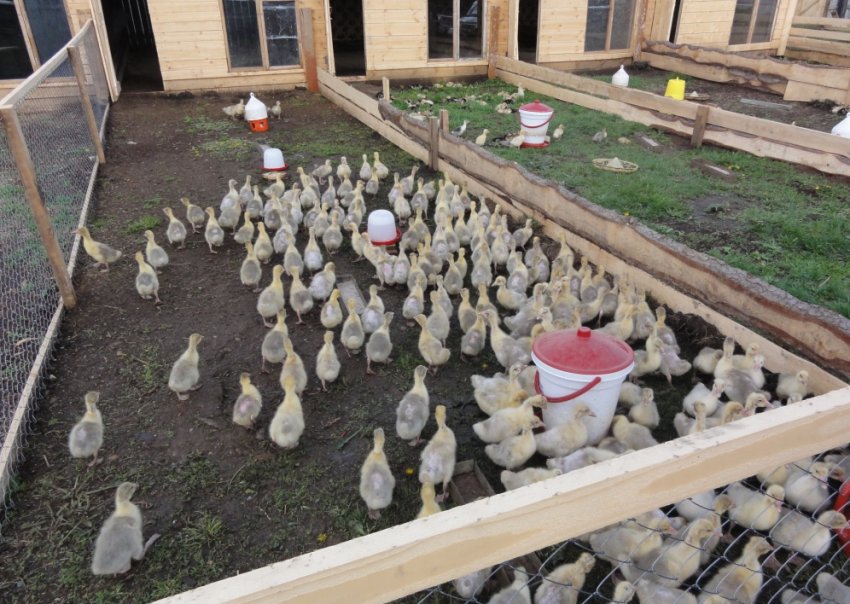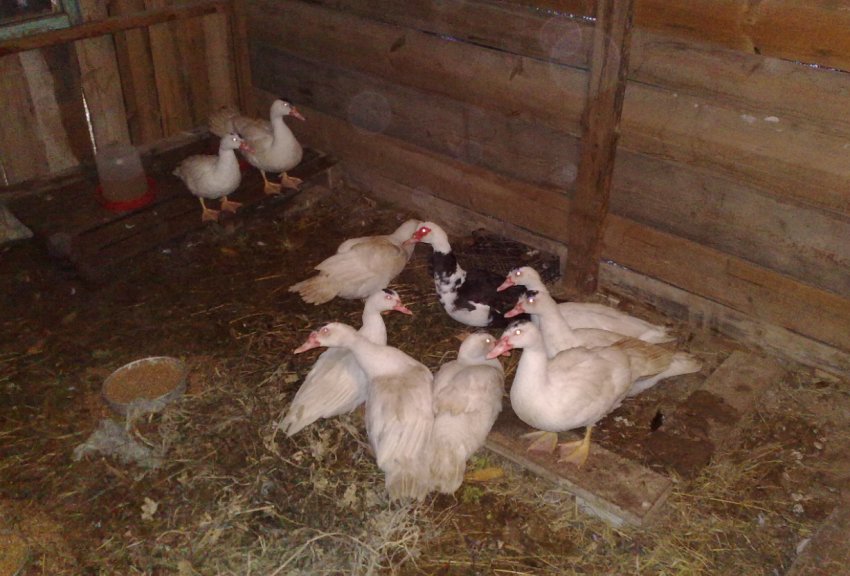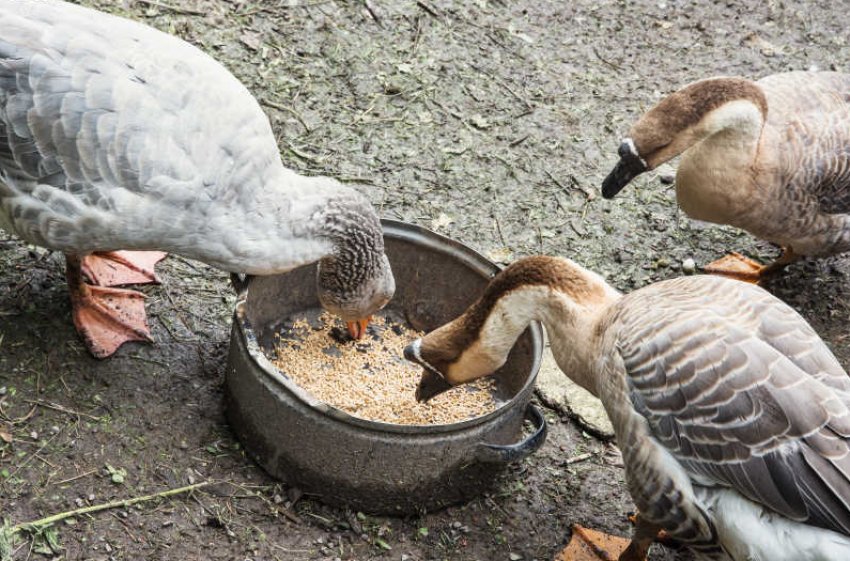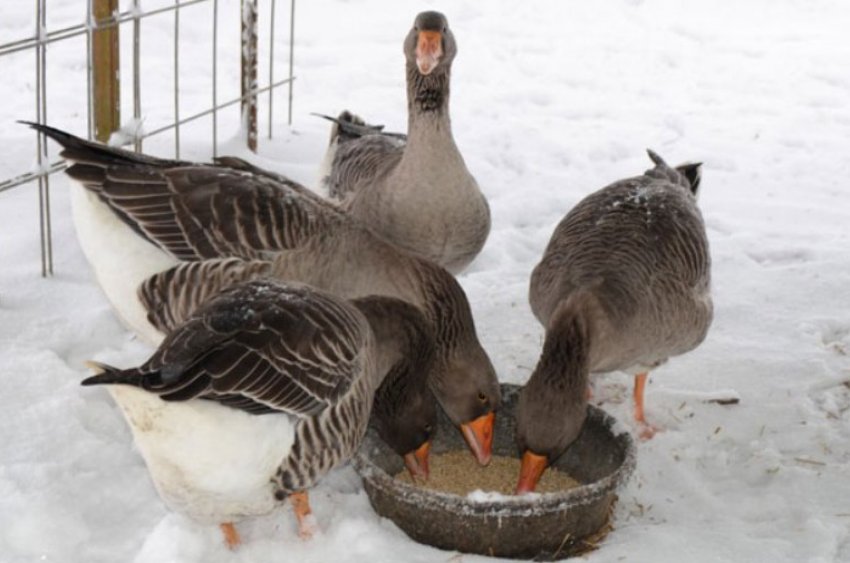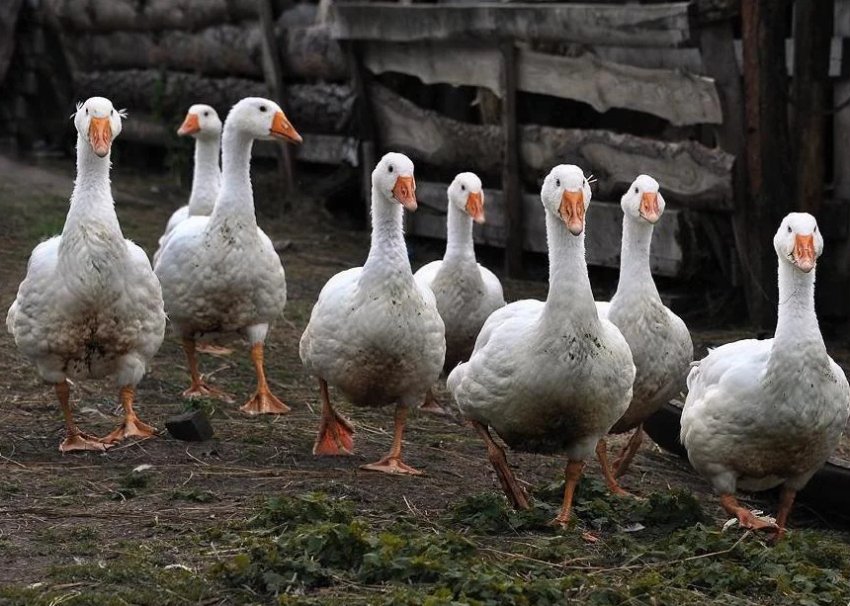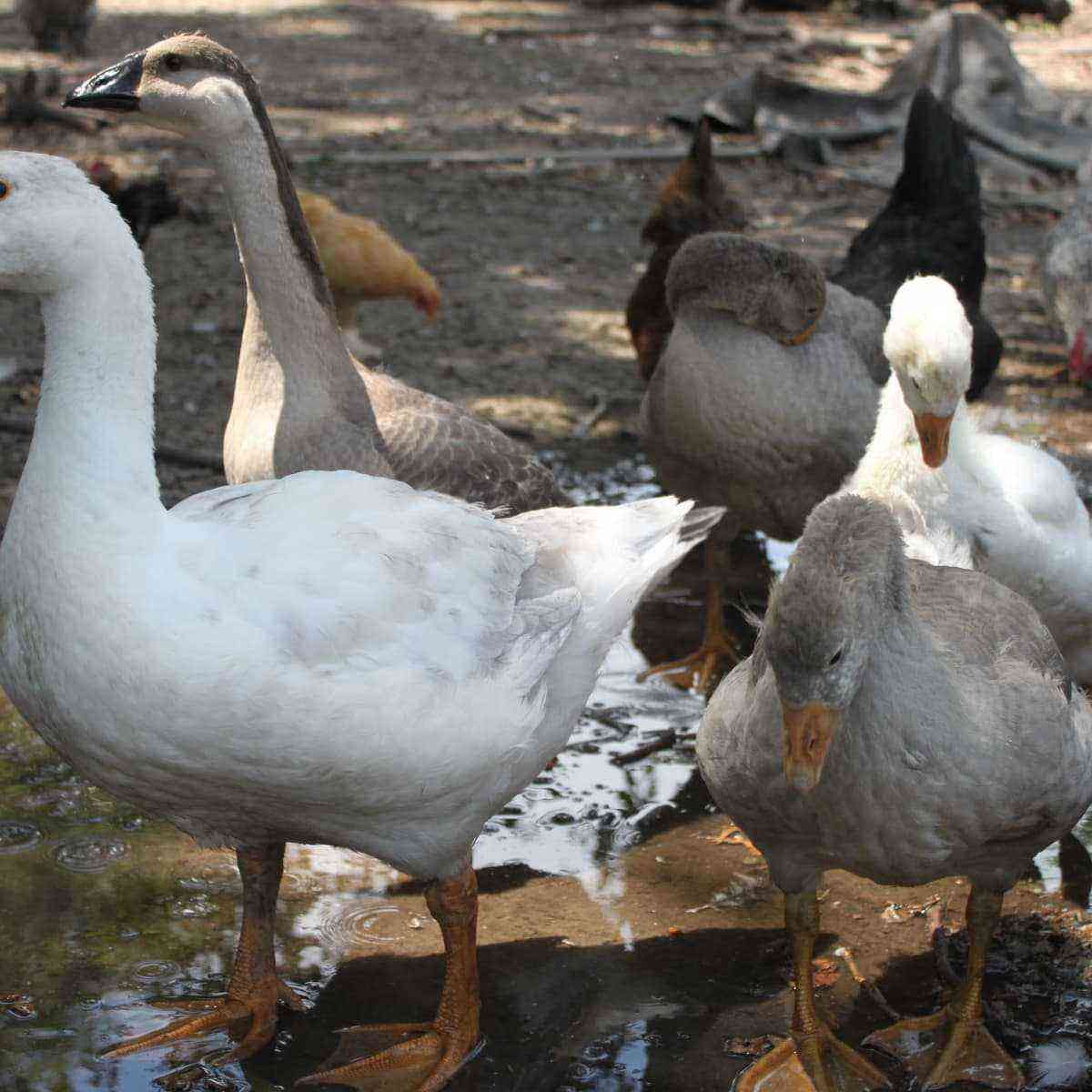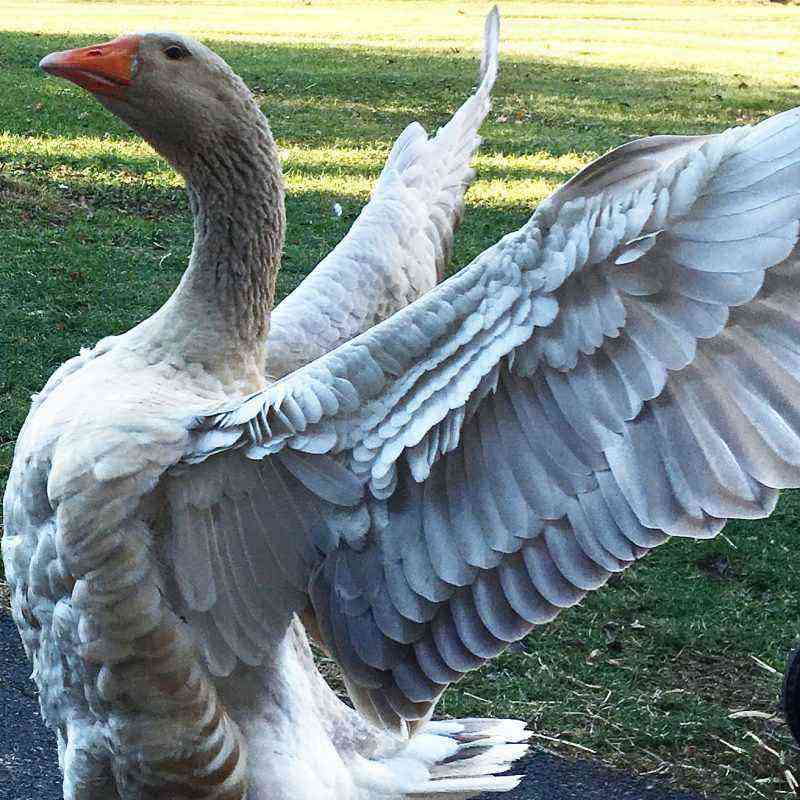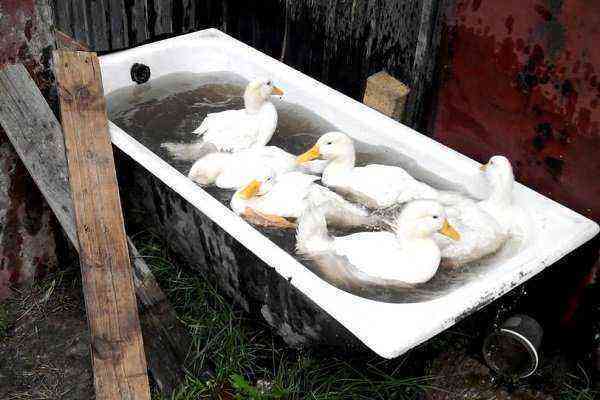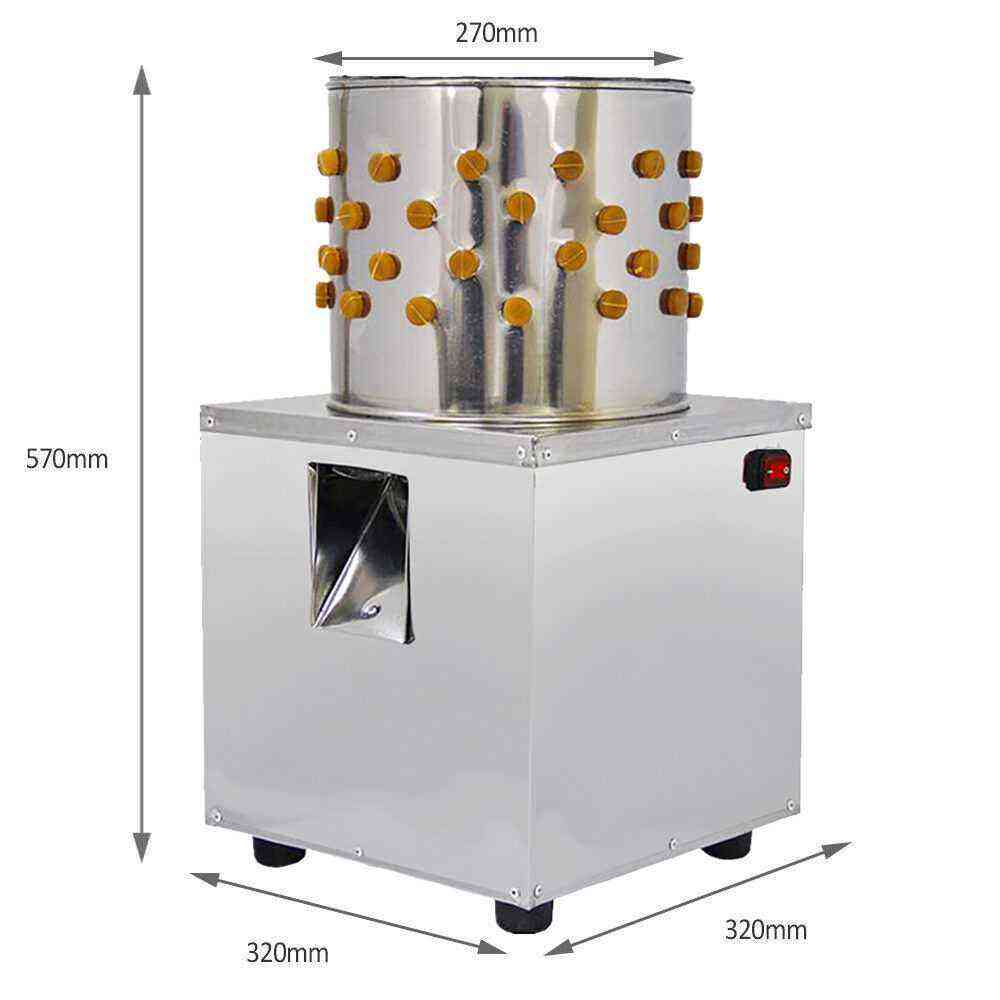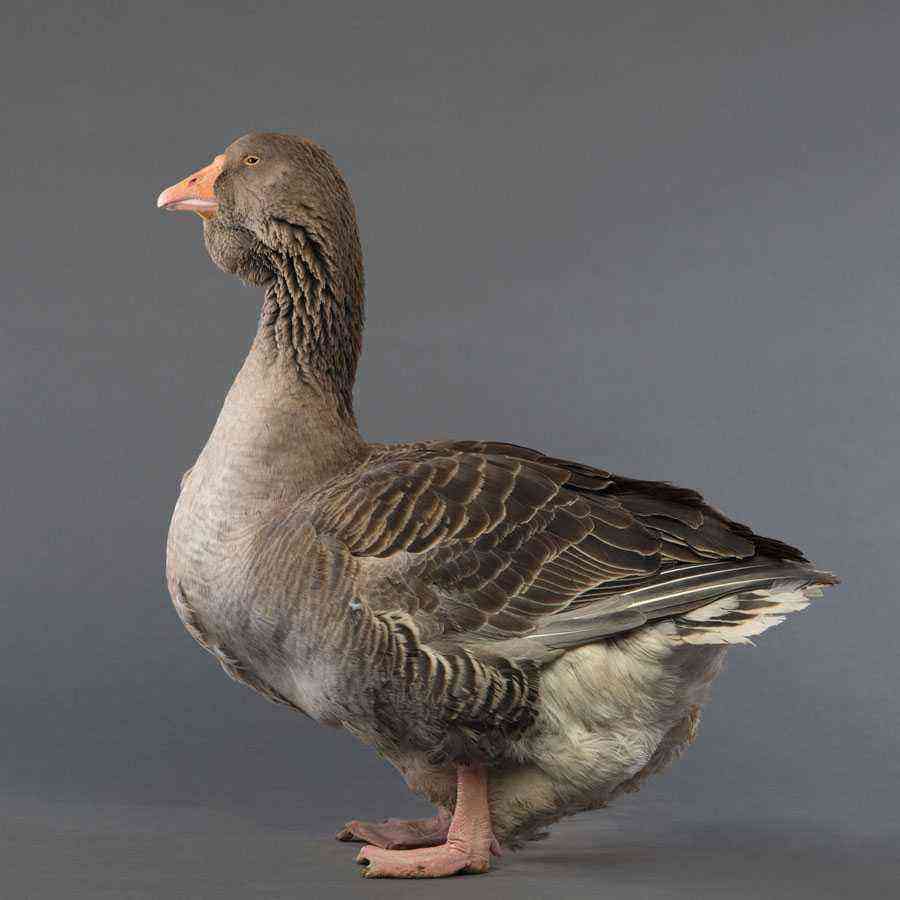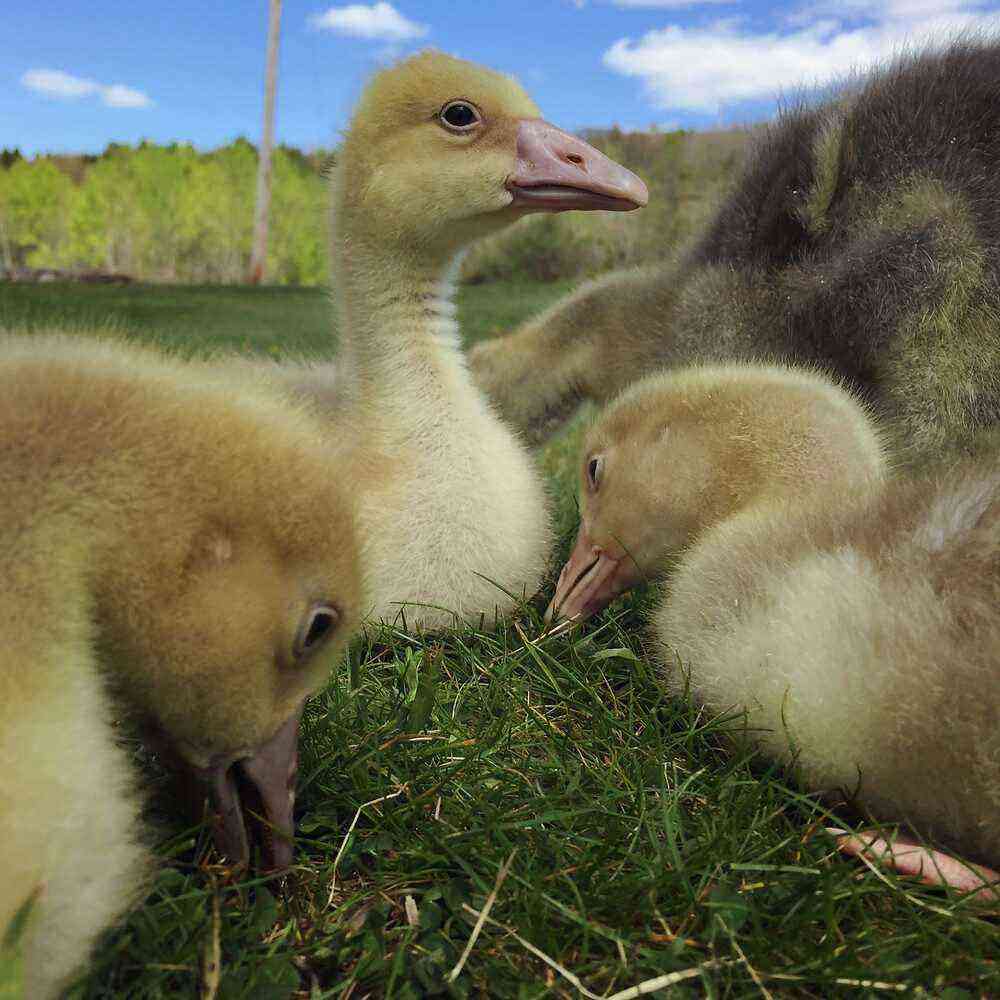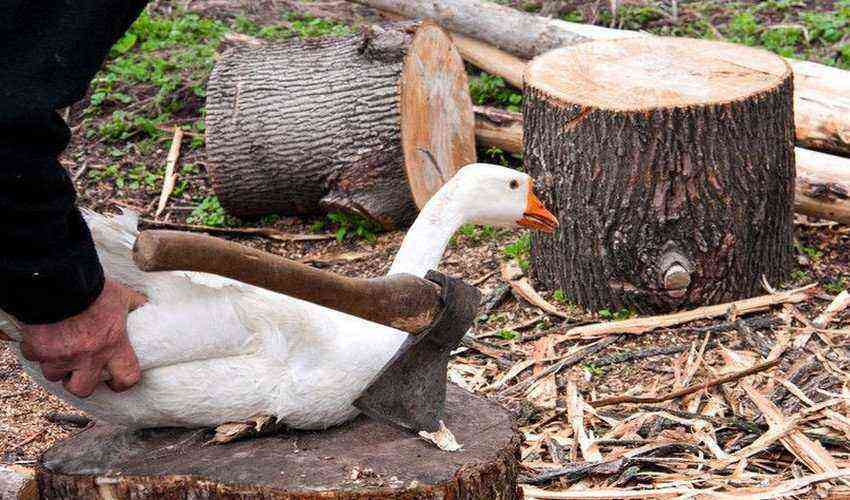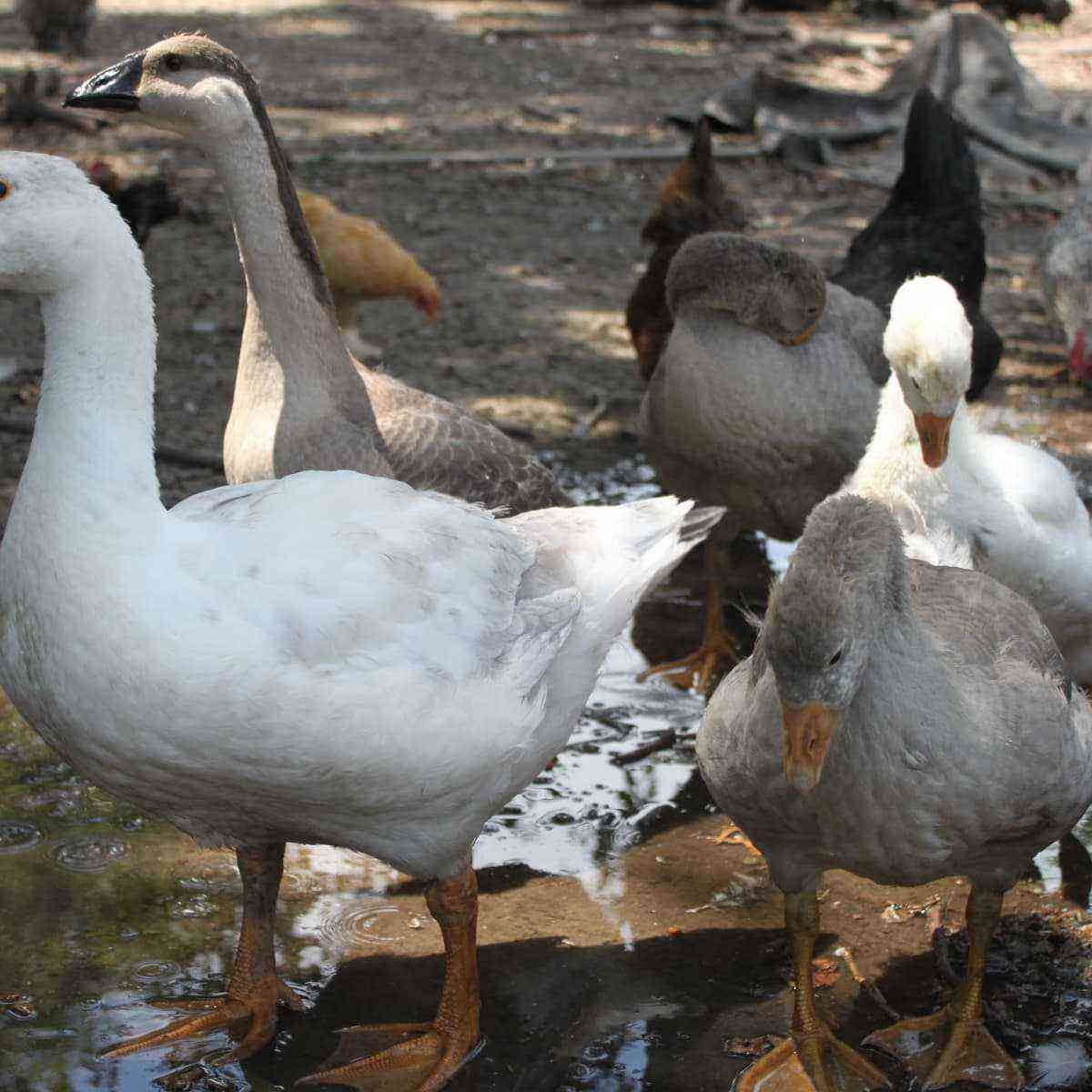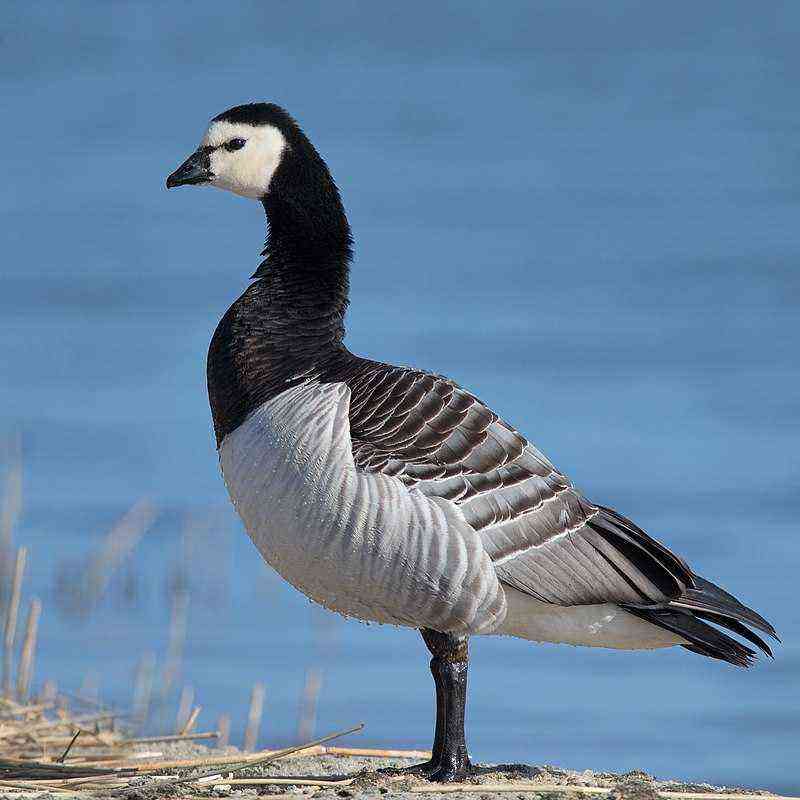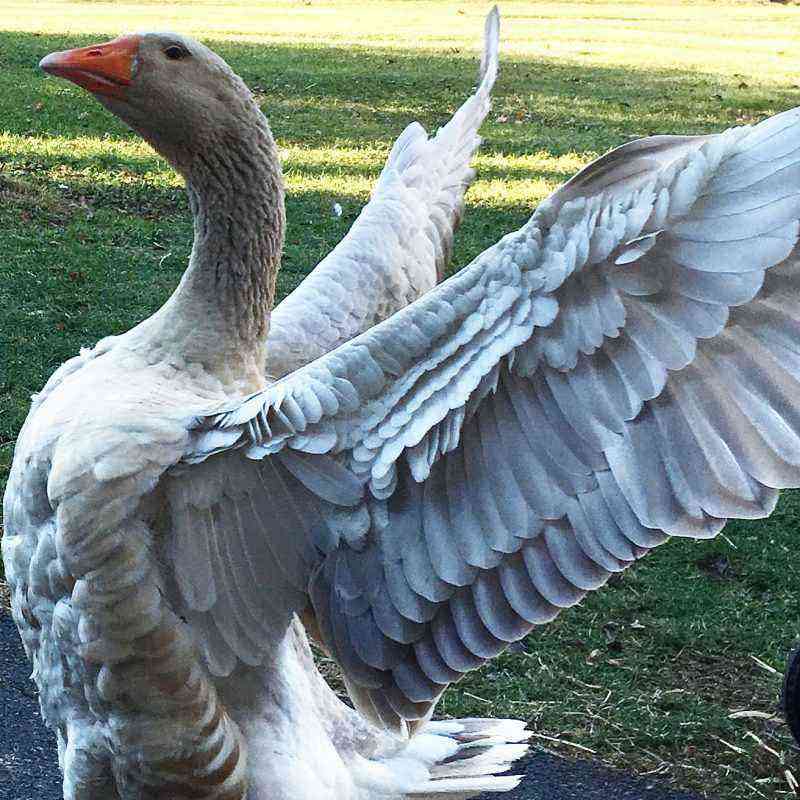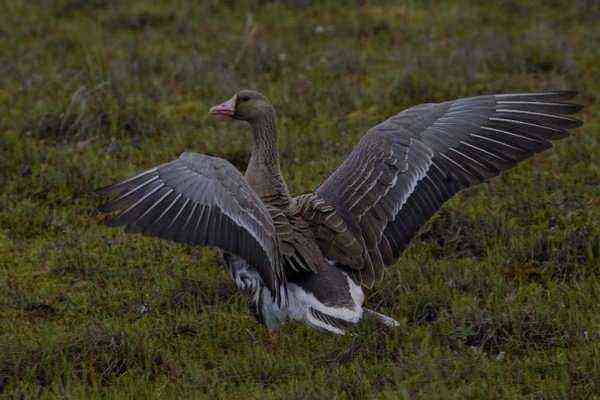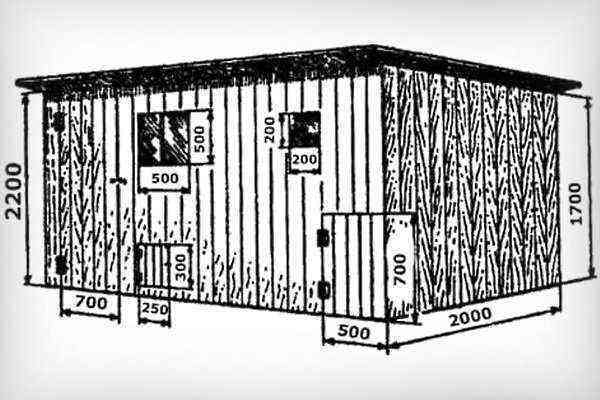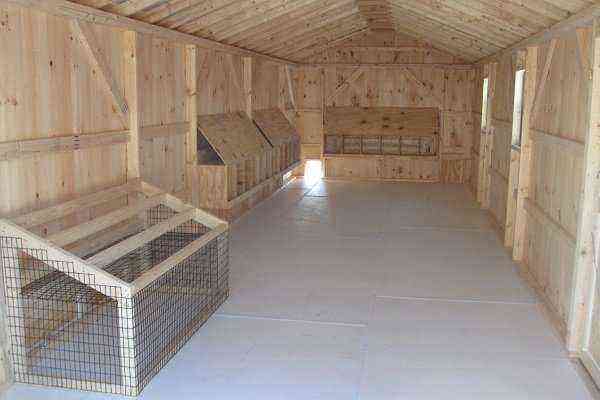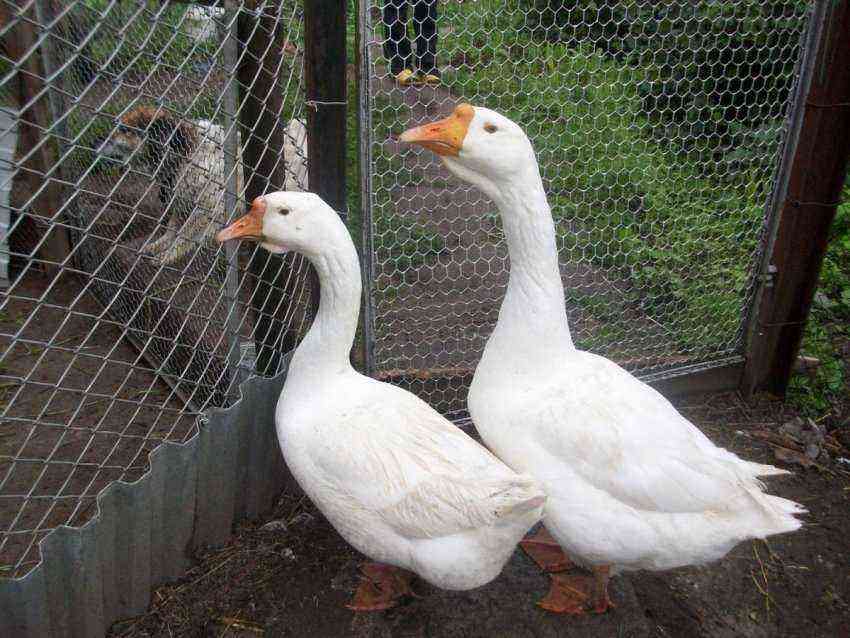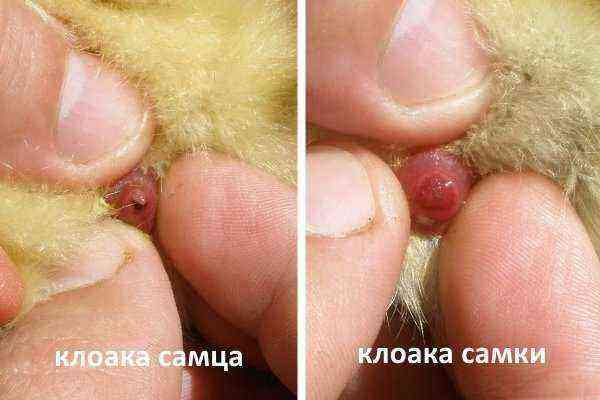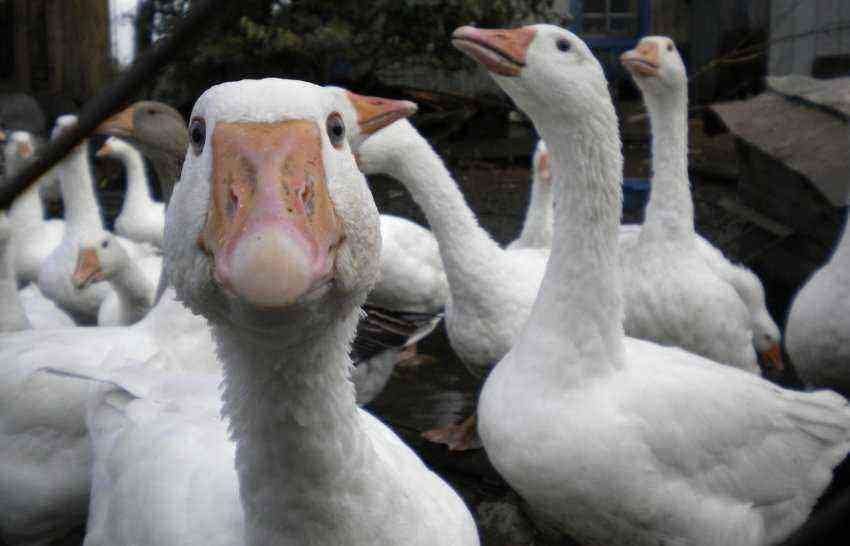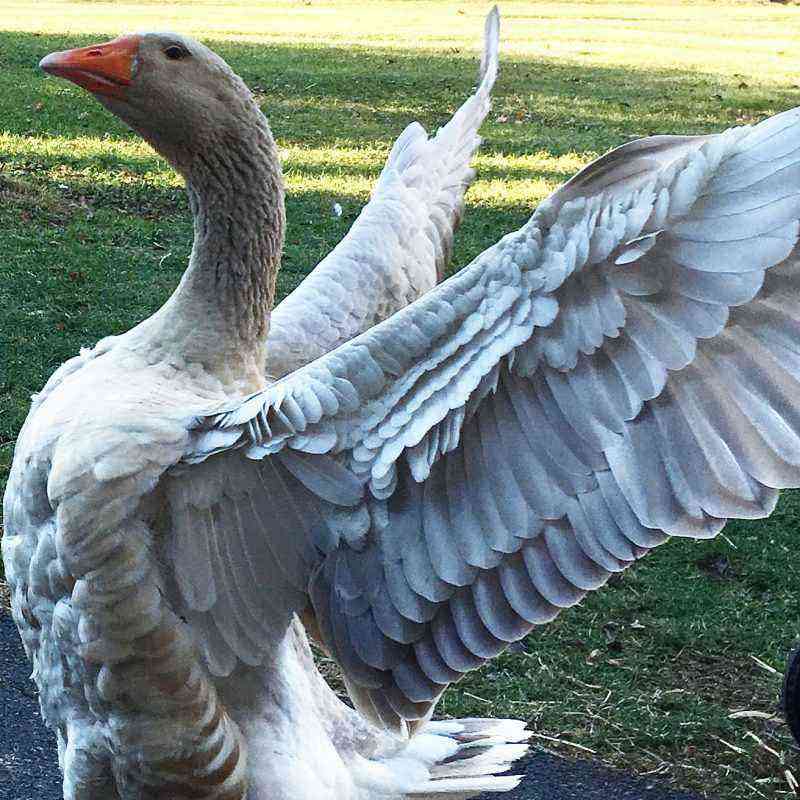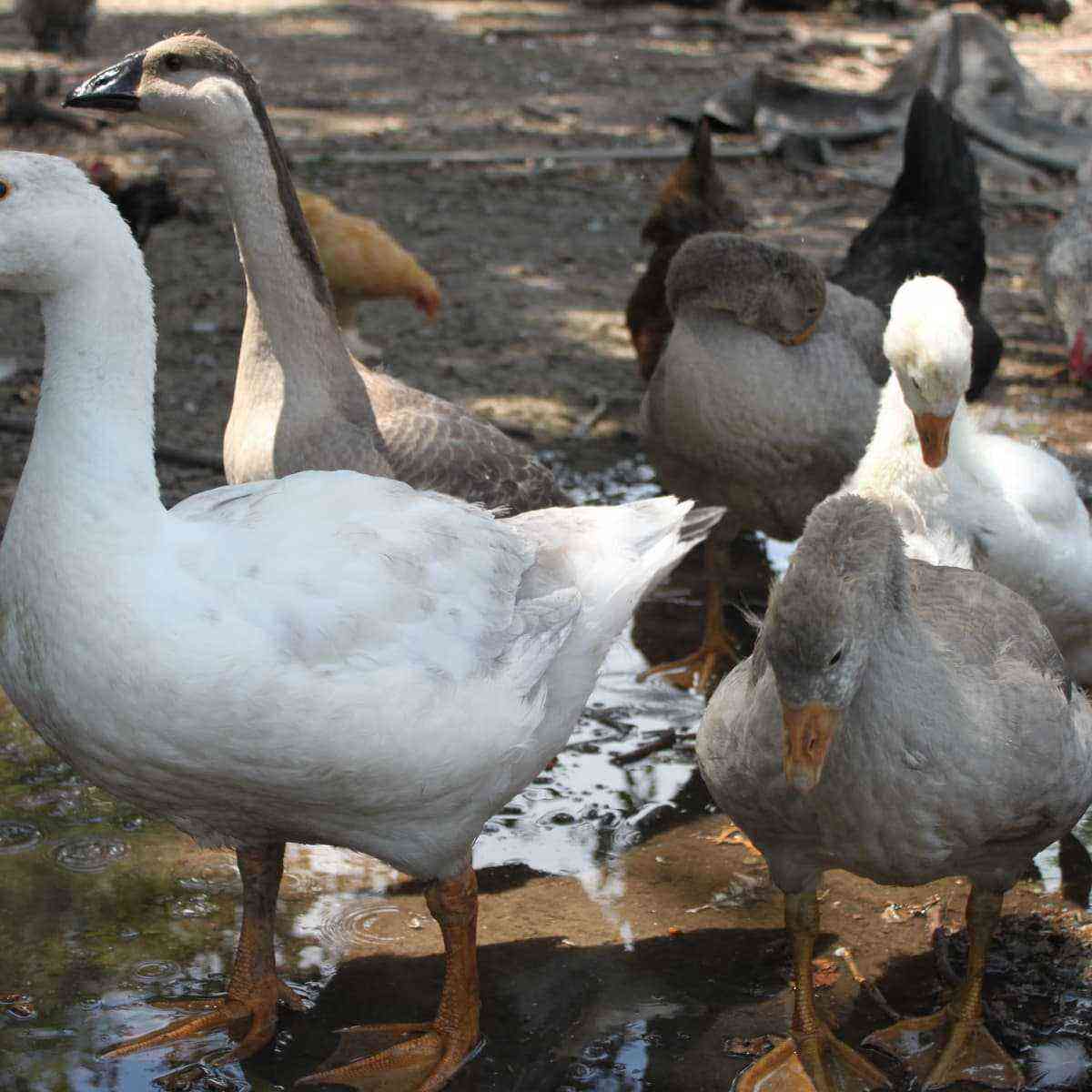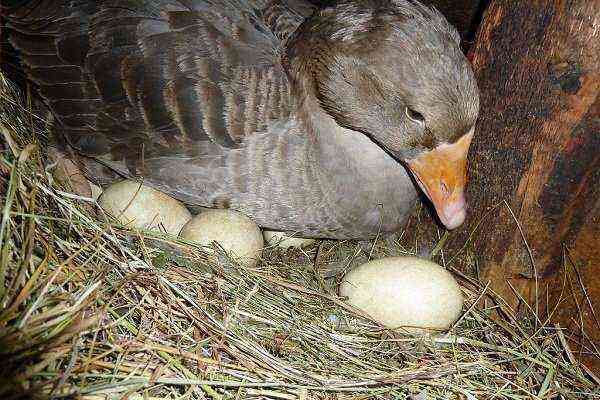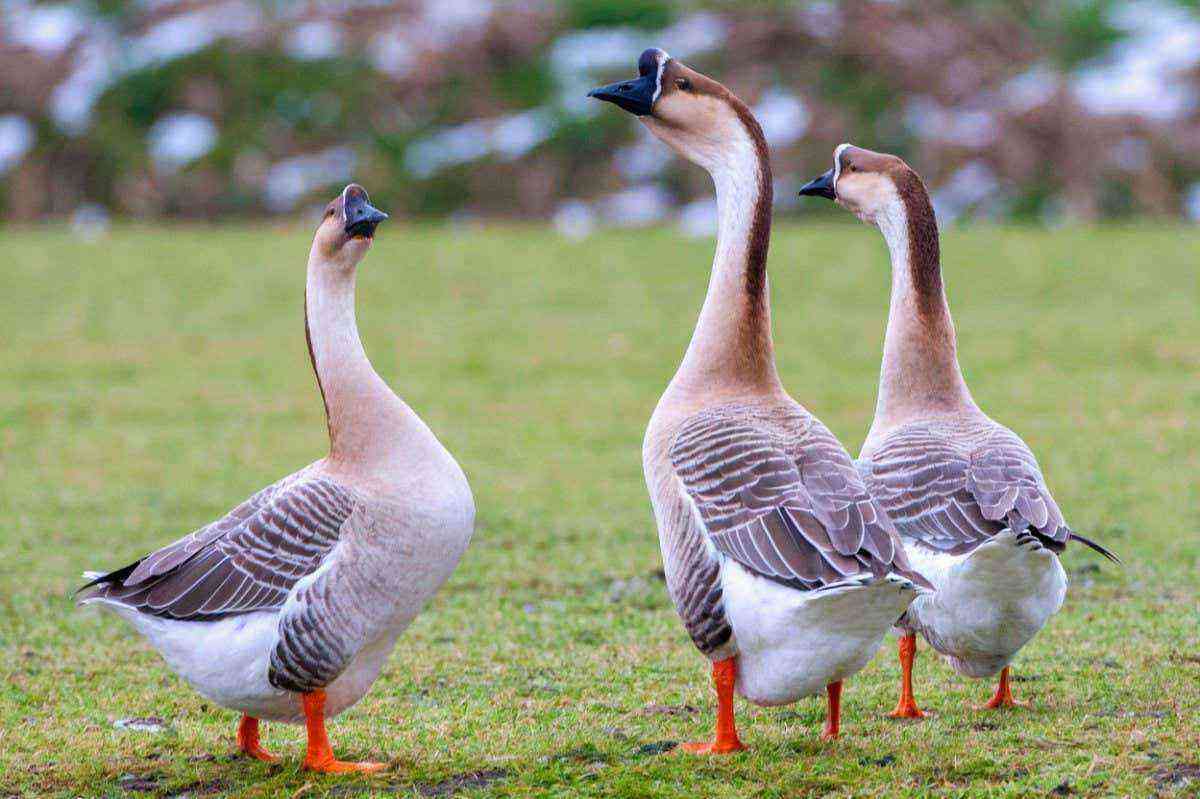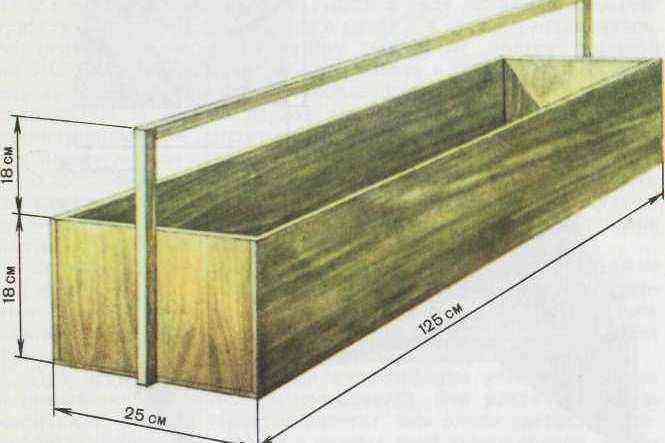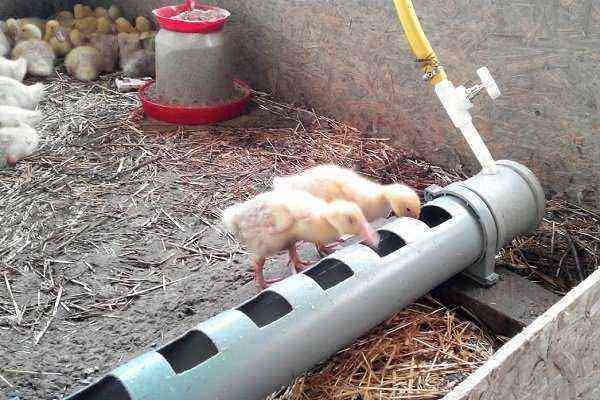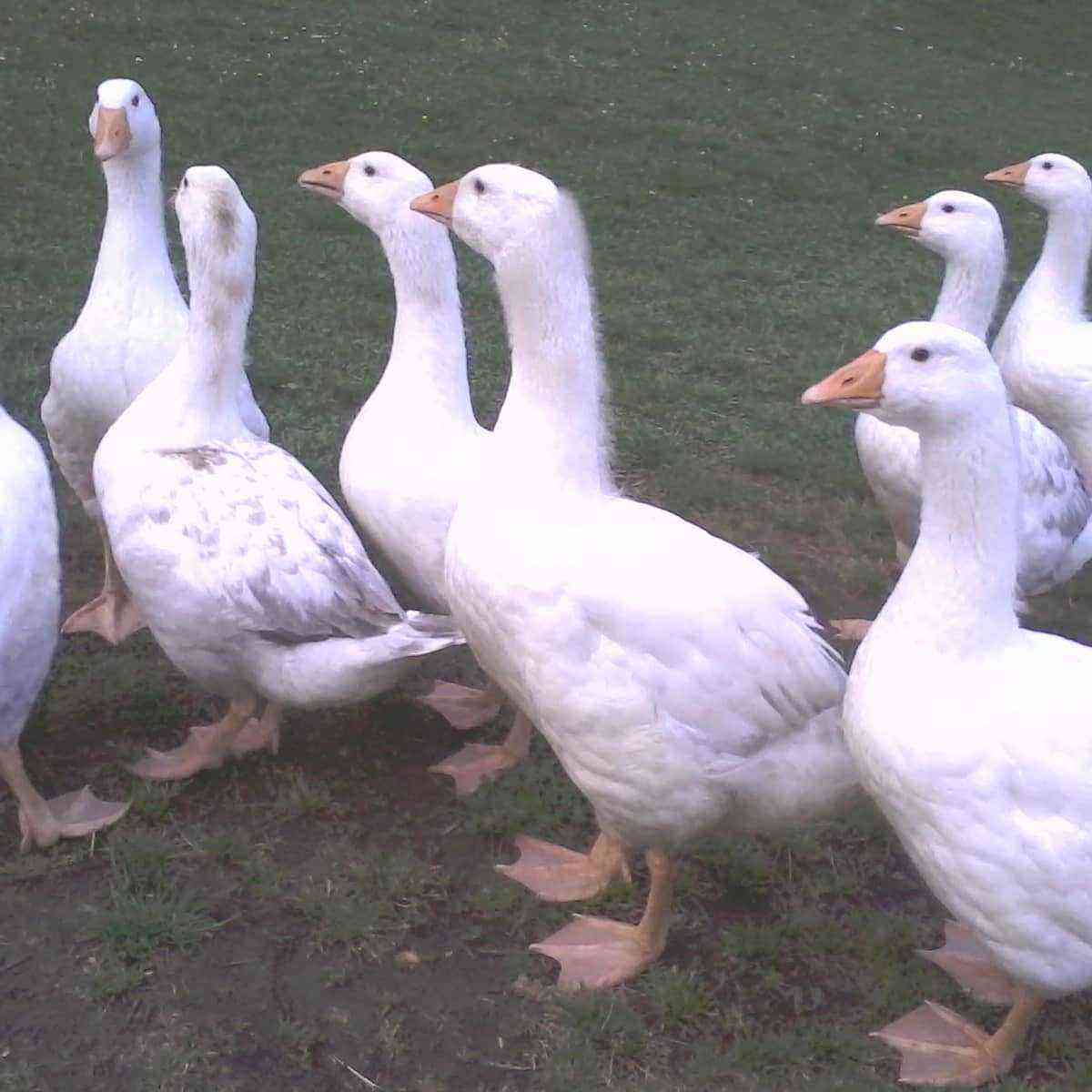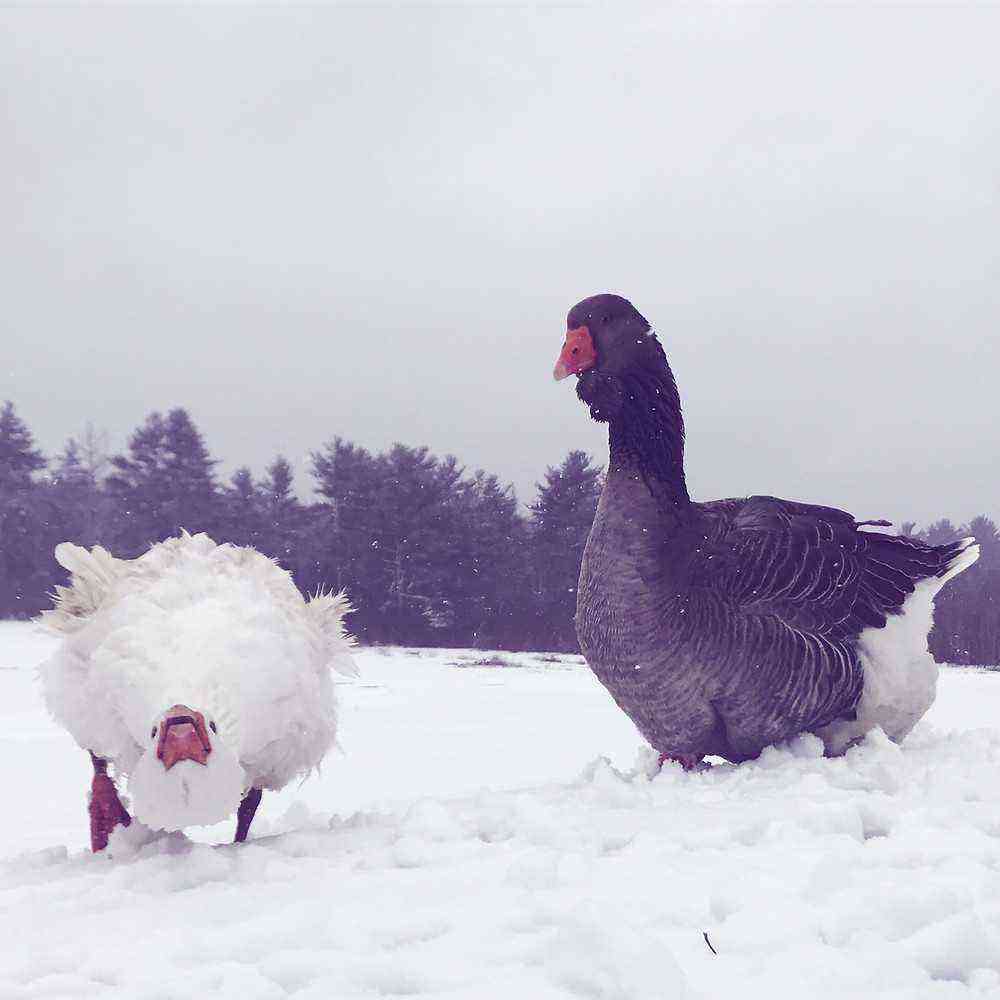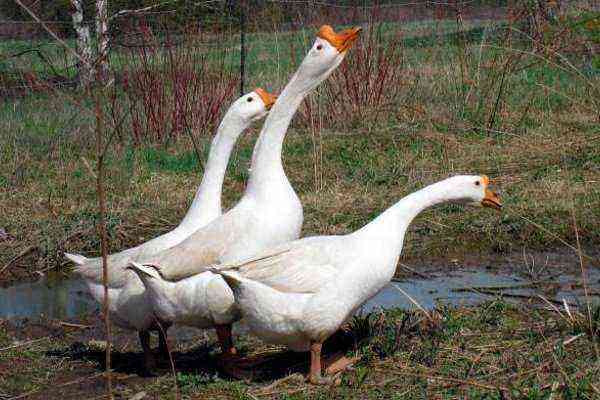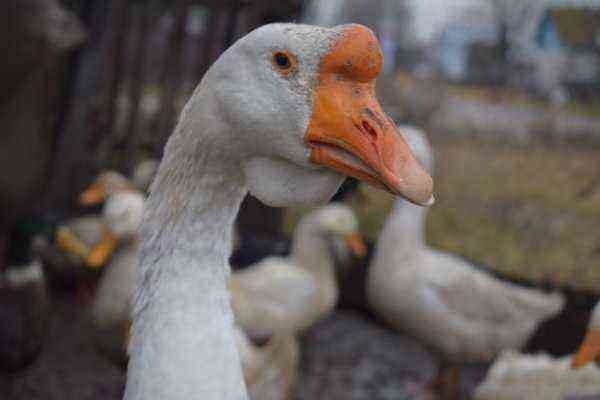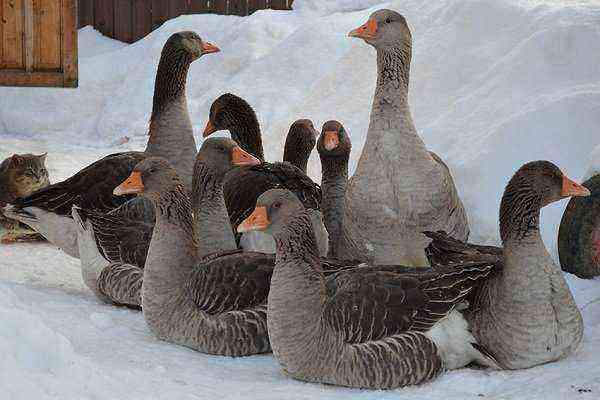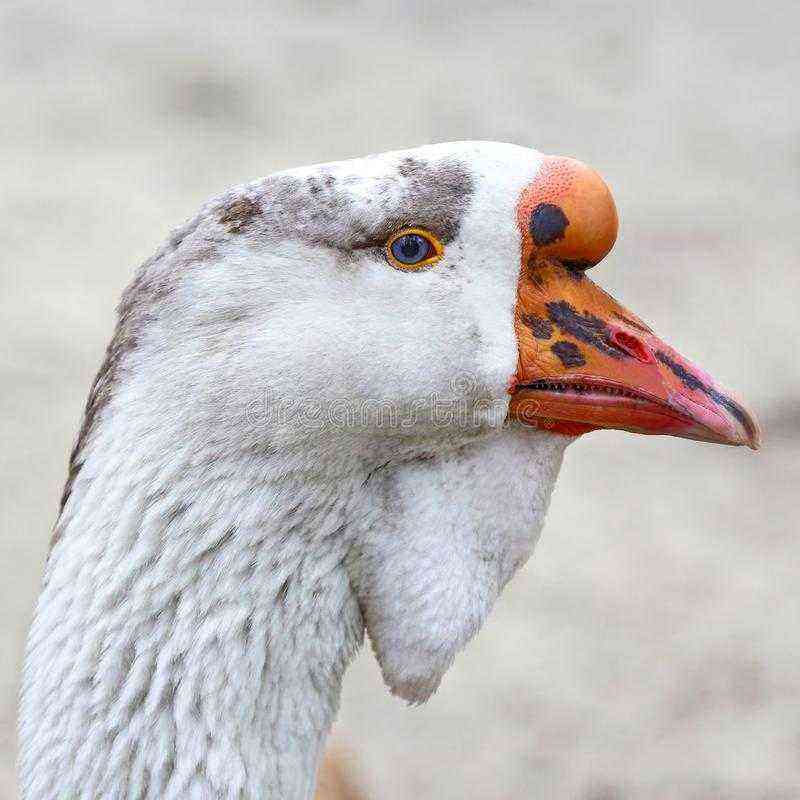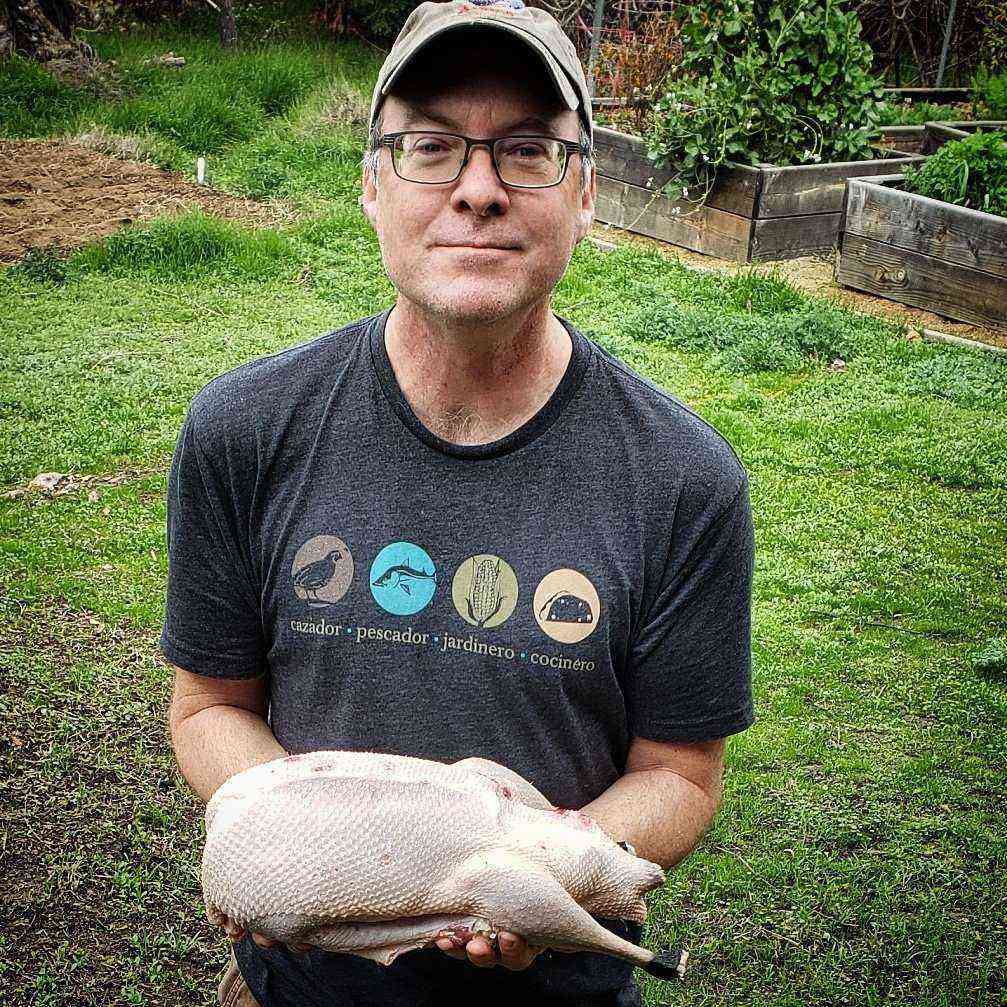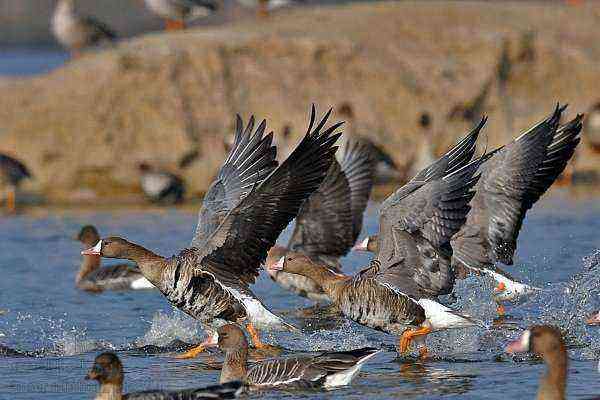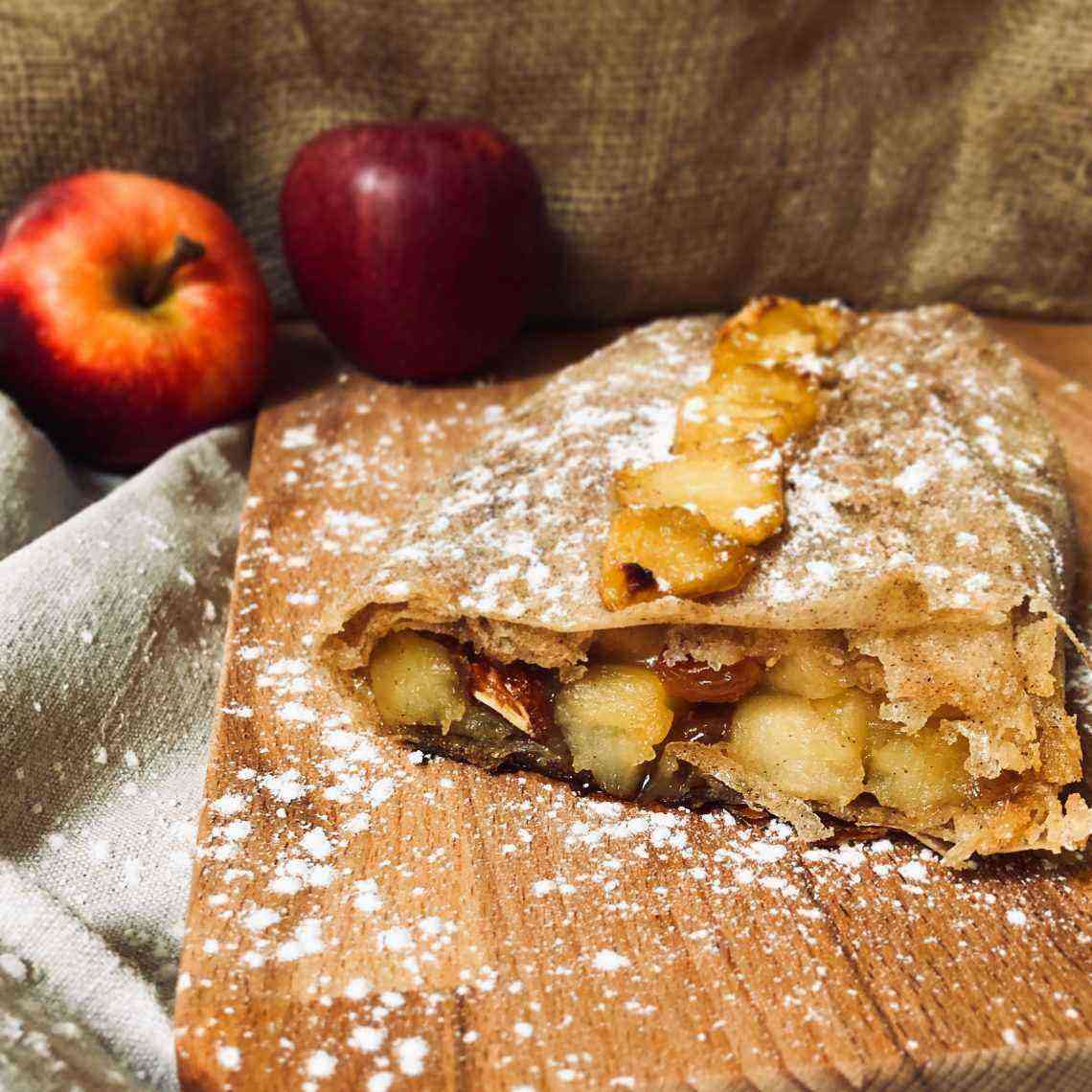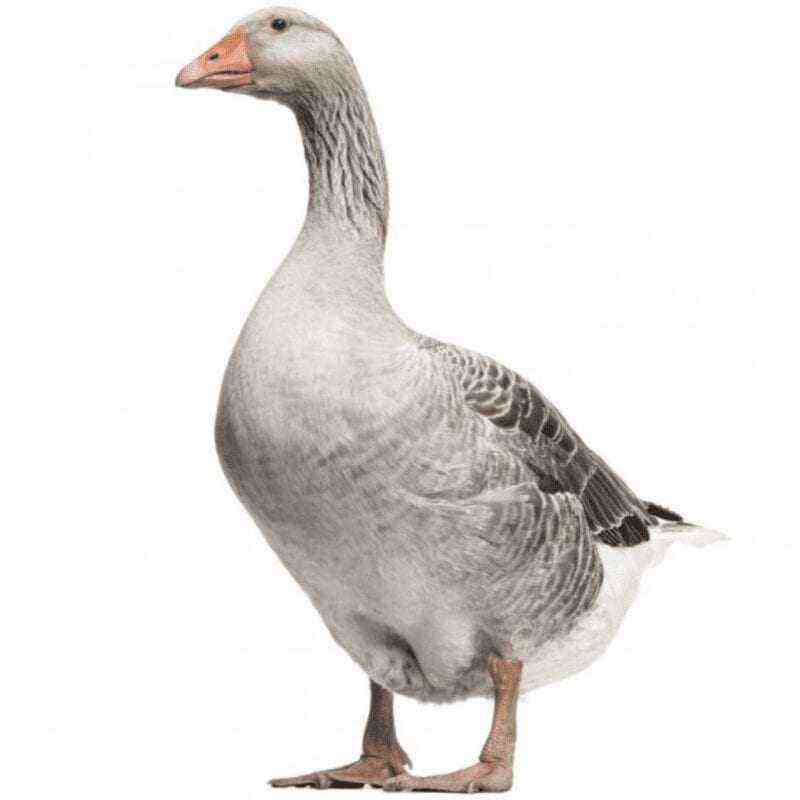Growing geese for meat is a profitable business in a market economy. The goose is one of the few agricultural birds that can find their own food on their own if there is a walking area and a small reservoir. The possibility of small investments and profit in a short time are the main incentives for a farmer who has started breeding geese.
Important! The feather is pulled out in the direction of growth, capturing in small bunches. The technique helps to preserve the carcass presentation.
Benefits of Goose Breeding
If there is a small body of water on the plot, you need to start a business of breeding and raising geese for meat. Having a good barn, paddock and dug-in water tank is also enough with proper care and a balanced diet.
The main benefits of the enterprise:
- quick profit: cultivation will take 3-4 months;
- in the summer months, in open water and free-range in the meadow, waterfowl will provide themselves with 80% of their food;
- goose meat is in stable demand in the market, in restaurants, supermarkets, which guarantees profitable sales;
- down, feather, bird liver can be sold additionally, that is, the enterprise is waste-free;
- goose droppings – an excellent fertilizer for garden crops, corn, cereals.
The goose farming business is not difficult and profitable even for beginner farmers.
Important! When choosing a breed, monitor the most common in the region. Waterfowl are already acclimatized to local conditions, the risk of loss of young animals is reduced.
What breeds are suitable
Starting an agricultural meat geese business, the main question is to determine the breed. More than twenty known “heavy” species of geese provide a choice depending on the task: a small number with a large weight or a large number with a weight of 4-5 kg.
Common breeds:
- Kholmogory breed (Kholmogory). They quickly gain weight, have good immunity, rarely get sick. They tolerate cold well. Unpretentious in nutrition. Pasture availability – 90% of the herd’s nutrition during the summer months. The goose kholmogorka is an excellent hen and mother. The disadvantages include low egg production and slow development without a reservoir.
- Tula geese. Undemanding in care and nutrition. Healthy meat, with a uniform layer of fat. Hardy, disease resistant. The disadvantage is slow growth and low weight (5–6 kg). They do not get along well with other breeds.
- Linden geese. Now – one of the most common breeds. Released in Russia. In five months, increases weight up to 7 kg, in a year – 11 kg. Dietary properties of meat. Good hardiness of goslings and egg production of geese (one egg per day). High adaptation to weather conditions. The disadvantages include – the mandatory presence of a reservoir for rapid growth and preservation of breed indicators, spring beriberi.
- Legart Danish. Released in Denmark. They gain weight in a short time: in two months the gosling grows by 5-6 kg. The main diet is grass, which saves feed costs. Resistant to diseases, adapt quickly, tolerate temperature extremes well. They have a calm, docile nature. Collection of down brings additional income: a goose can be plucked at the age of one, then every two months you can get high-quality down. The disadvantages include low egg production, weak immunity of goslings, and the high cost of purebred chicks.
- Large grey. The name contains the main parameters: gray plumage, geese increase their mass in a short time: at the age of two months – 4-5 kg, adults – 9-10 kg. Adapted to cold weather, unpretentious to food. Differ in egg production – up to 45 pcs. per season, the yield of ducklings is 60–70%.
- Kuban. They are distinguished by good egg production, rapid weight gain and disease resistance. A breed of light direction: the weight of an adult bird is up to 6 kg, a gosling at the age of 2 months is 3–3,5 kg. High egg production (80–85 eggs) and chick yield (80%). By selling eggs and goslings, they receive additional income. Light weight and a grayish tint of meat are attributed to the shortcomings of the breed.
- Chinese breed. Refers to light meat. The weight of two-month-old young animals reaches 3–3,5 kg. Adult male – 5-6 kg. Dietary properties of meat, practically without a fatty layer, are highly valued by connoisseurs. Eggs will bring additional income (100–120 pieces per year). The “Chinese” are not picky in their diet, but they require a warm room without drafts, they do not tolerate cold weather.
Starting a goose breeding business, the first purchase of goslings is best done from well-known breeders, experienced, with their own mother flock. When buying, be sure to specify the vaccination of parents: hepatitis, paratyphoid, gastroenteritis. When buying young animals, the presence of vaccinations is also specified. Chicks are chosen active, with dry tummies, clean, slightly harsh fluff. A sign of a daily gosling is an egg tooth on its beak. There should be no mucus, traces of blood, particles of undigested food in the litter.
Eggs with a mother hen
The laying period of the goose ends with the incubation of the chicks. A caring mother carefully covers the nest with fluff, turns the eggs over for even heating, covers them, leaving the nest for feeding.
Signs of a bird sitting on eggs:
- almost constantly sits in the nest, leaving only to eat;
- the nest is covered with down, the bird buries the laid “laying eggs” in the down.
After making sure that the goose has “sat down”, you can lay eggs for incubation. The best time is late evening, the bird is getting ready for bed, will calmly respond to the procedure, and by morning will get used to laying. The nest is located separately from the gander and the main herd.
Important! Geese are devoted to the couple. A goose that has lost a male may not incubate eggs for several years.
If there are several hens, they are separated by partitions to avoid “stealing” eggs from each other. Otherwise, geese can break most of the eggs, rolling from nest to nest, or overcool them: the female is able to heat no more than fifteen eggs in one clutch. Goose is a very caring mother.
Incubation of eggs lasts four weeks, during this period you need to carefully monitor and care for the hen:
- pick up from the feeding nest. Often the bird is so caring that it forgets about its own nutrition;
- the diet of the mother hen consists of the best grain, dry food;
- install a small container of clean water next to the nest, change daily;
- raise the goose daily for half an hour for walking and bathing. Install a bathing container near the feeding place, otherwise the anxious mother will run to the nest without replenishing her strength.
On the eleventh day, during the goose’s walk, unfertilized eggs are culled: they are illuminated with an ovoscope, determining the presence of an embryo. Otherwise, the “sitting” egg may explode from the heat in the nest, staining and ruining the rest of the masonry.
On the twenty-eighth day, plus or minus one or two days, goslings hatch. They are not taken immediately from the hen, the chicks must warm up and dry. The shell is removed from the nest. In case of difficult pecking, the chick can be helped a little: remove pieces of the shell at the pecking site. If traces of blood are found, stop. Having placed the babies in a box, they heat them with lamps until the last one pecks.
After that, the goslings enclose their mothers. The goose has strongly developed maternal instincts. Together with “their own”, the bird will painlessly accept “foreign” yellowmouths, and will anxiously look after them. It should be taken into account that an experienced mother will do an excellent job with two or three dozen children, it is better to let only ten or twelve babies go to a young mother hen.
Did you know? A couple of days before biting, the goslings “talk” with the mother hen if the egg is overcooled or overheated.
For two days, the mother and chicks are not allowed outside, even in very warm weather. They keep it in a dry, warm room, monitor the nutrition of the mother and the behavior of the offspring until it gets stronger. The incubation instinct varies from breed to breed. They sit well on eggs. Large gray, Kuban, Tula breeds. You will not get a hen from Chinese, Legart. Incubators are used to breed these geese.
Eggs in an incubator
An effective way to get viable offspring is to lay eggs in an incubator.
When choosing eggs, the main indicators are taken into account:
- weight and size. The larger the eggs, the larger the chicks. From large eggs, chicks hatch later, there is a risk of overexposure, which will lead to dehydration of goslings. Eggs are sorted by size before laying. Calibration will reduce the percentage of “substandard” offspring. Bookmark produced in three groups: large – medium – small with a distance of 5-8 hours;
- the form. The correct ellipse, without concavities, “belts” and growths – a sign of quality. There is a difference between a blunt and a sharp end;
- surface. The shell should be even, smooth, without damage. The color is uniform. Marble stains are a sign of uneven pigment. Experienced poultry farmers say: the darker the color, the better the offspring;
- protein and yolk quality. The parameter is checked with an ovoscope. The yolk is located in the center of the egg. The air chamber is at the blunt end. The presence of large air chambers (more than 9 mm) is the reason for culling: the egg was stored for a long time;
- external pollution. A clean egg is a guarantee of healthy goslings. Abundant dirt on the surface indicates unsanitary conditions of the herd, possible diseases, high mortality of offspring.
It is better to buy eggs for laying from owners who have been breeding geese for a long time, have a healthy herd with a high percentage of goslings, or collect them yourself.
Important! The collected eggs are placed horizontally, it is not necessary to wash them before laying.
Cultivation
Unpretentious to the weather, conditions of detention and nutrition, domestic waterfowl grow quickly and weigh 3–3,5 kg by two months. Poultry meat by this time is gaining the necessary nutritional qualities, juicy and soft, easily amenable to heat treatment. It has the highest market value. Mixed poultry feeding (greens and grains) allows later slaughter.
They determine how much to raise a bird for slaughter individually, but in this case it is not worth keeping it for more than 5 months: the meat will become tough, it will be more difficult to sell it, the cost will increase, which will significantly reduce the profitability of the enterprise. The time of slaughter of a bird is determined by the absence of stumps of new feathers after a natural molt. To check, you need to hold your palm against the growth of the pen, by touch determining the presence of stumps.
Did you know? The domestic goose is a long-liver, can live up to 30 years.
Caring for goslings in the first days of life
The first decade for goslings without a hen is the most crucial period, especially for beginners.
Key points for baby care:
- Housing device. The room should be warm, without drafts. Temperature – + 27 ° … + 29 ° С, area at the rate of 1 m² for 10 goslings, large sawdust as bedding. Along the back wall there is a place for chicks to rest, on the opposite wall there are feeders and drinkers. Heating and sufficient lighting (up to 20 hours a day) will be provided by an infrared lamp.
- Food. Gosling food should be crumbly, sticky food can get into the respiratory tract of the chicks. Bone meal, fat-free cottage cheese, eggs are a must-have food for young goslings. On the first day, babies are given only a hard-boiled egg mixed with a small amount of water. Starting from the second day, you can gradually mix in crushed grain, preferably corn, gradually introduce crushed barley and wheat into the diet. Babies need to be fed every three hours. On the second day, greens are introduced into the feed: chopped nettle, young onion feather, Chinese cabbage, young lettuce. Greens make up half the amount of feed. The main rule is that the grass should be juicy and fresh.
- Walking and swimming. Starting from the third day, babies are let out for a walk, even if they grow up with a hen and the weather is sunny. In cold windy weather, goslings are best left in the barn: unpretentious chicks are afraid of drafts and cold. For swimming in the yard, the goslings are given a small container of water. You need to make sure that the kids do not overbought. The mother goose knows perfectly well how long the chicks need to be in the water, without it, the kids need to be sent to a dry room in 30 minutes.
- Vaccinations. The first vaccination – against salmonellosis: on the third day after birth, if the parents were not vaccinated; on the 10th – if the adult herd was grafted. The second vaccination against viral enteritis is mandatory, otherwise the whole herd may fall. The vaccination is given with a live vaccine on the 28th day after birth. For the prevention of colibacillosis, babies are given drink instead of water for the first three days: propionic acidophilic broth culture in proportion to 10 ml of water 1 ml of the drug. Without vaccinations, breeding geese carries the risk of diseases affecting the entire herd in a short time.
Care in the first weeks
Goslings grow quickly and adapt to living conditions.
Did you know? Excellent hearing of geese allows you to hear within a radius of 50 m.
Experienced poultry farmers advise how to raise healthy chicks without the risk of death in the first month:
- after a week, reduce the number of feedings to six, increasing portions by a third. Chopped peas, boiled potatoes, carrots are introduced into the diet, kneaded on yogurt or skimmed milk. Add fish oil. The water in the drinkers is constantly replenished. Chicks get the main amount of vitamins from fresh herbs, which make up half the amount of food for goslings during this period.
- In warm weather, goslings are driven out into the yard for the whole day. They determine how long the goslings bathe by plumage: until the main feather appears – no more than 20 minutes without a break. The fluff of babies gets wet quickly, the chicks get cold and get sick.
Care after the first month
Four-week-old goslings are covered with real feathers, after a month they can be driven out to the reservoir, the diet is in the morning and in the evening. Being in nature all day, young animals find food on their own: greens, bugs, midges make up the diet of adolescents, nourish the body with vitamins. On the water, geese get stronger physically, quickly gaining mass. When grown in a paddock, feeding is carried out three times. 60% of the volume is greens, there should always be clean water in the drinkers. They dig in a large bathing tank, compensating for the lack of a natural reservoir.
Did you know? Tibetan monks consider the goose to be the incarnation of the god Shiva, the ancient Romans considered the clawed bird to be the favorite of the god of war Mars.
Goose house arrangement
Domestic geese are a bird unpretentious to housing. Starting the construction of the premises, you need to consider how many waterfowl are planned to be settled: one bird per 1 mXNUMX of area. Otherwise, gas pollution and dirt will lead to the spread of diseases and the death of the entire herd.
The main building parameters:
- facade orientation – the south side, an open fence is being built here. Height – no more than a meter, domestic geese do not fly;
- barn height – two meters, wall thickness – 250 mm;
- material: brick, shell. The walls of the boards are double, inside there is a layer of insulation. Wooden doors for the winter are insulated on both sides;
- long daylight hours for geese – a condition for good appetite and growth. The walls are provided with window openings of at least 15% of the wall area, inside – lighting. If you plan to hatch offspring. Separate fences are assigned for geese. The room for young animals is equipped with infrared lamps;
- floor – 200–250 mm from ground level, wooden, with a slope for better runoff of slurry. The litter is arranged from sawdust, straw, hay – at least 0,5 m, change according to the degree of pollution as often as possible to avoid the development of bacteria and parasites;
- the ceiling is flat, made of two layers of boards or plywood, with a layer of insulation. The roof is sloping, the attic is used for storing equipment or hay, straw;
- proper ventilation is an important condition in the construction of a goose coop. Holes 5–8 cm in diameter are made under the ceiling, for the winter they are sealed with a mixture of clay and sawdust to avoid drafts. Ventilation of the room during the cold period – through the open door;
- drinking bowls are installed on the side wall. Waterfowl drink a lot, the stock must be replenished constantly, the water must be clean, at room temperature;
- feeders – long enough to avoid crowding: 25-30 cm per bird. The sides of the feeder are raised to a height of 10–15 cm to avoid scattering of feed;
- keep the temperature in the barn at least +20°C, after the appearance of offspring – + 27 ° … + 30 ° С.
Conditions of keeping and feeding
Fattening geese for meat is not a difficult task. Waterfowl are unpretentious to feed, omnivorous with a few exceptions. By properly balancing the diet and feed composition, profit from the sale of delicious dietary meat is received both in winter and in summer.
In the summer
In the summer, in the presence of a reservoir and green range, waterfowl will provide themselves with good nutrition for the whole day: bugs, worms, greens in the meadow, duckweed, young reeds, algae in the reservoir will provide 80% of the daily nutrition. Morning and evening feeding consists of grain mixtures. Wet mixed feed mixers are an additional growth stimulator.
Own garden is a source of food for geese. Ripe cucumbers, zucchini, fodder beets are suitable as feed throughout the day if the bird grows in a paddock. Be sure to provide the geese with green mass from nettles, dandelions, yarrow, for better digestion of food, gravel and sand are poured into the fence.
In the morning and in the evening they give boiled potatoes, the best grain: crushed corn, wheat, barley. Dry food is rarely given to geese. Grain mixtures. Compound feed is moistened with water, yogurt. Water containers should always be filled: an adult bird drinks up to 2 liters per day.
In winter
In the cold season, you need to maintain proper nutrition for fattening geese:
- three meals a day, at the same time, to develop a reflex;
- ensure the constant presence of warm clean water in the drinkers;
- diet: high-calorie grain mixtures, moistened compound feeds. Grated fodder beets, pumpkin, boiled potatoes, harvested greens, silage are treats loved by geese. Boiled legumes, meal, cake will replenish protein reserves;
- needles are used as a vitamin supplement, it will also increase egg production;
- to prevent beriberi, feed yeast is carried out: the grain is soaked overnight with a solution of warm water and baker’s yeast. Waterfowl will get lactic acid during feeding.
How to hack and pluck a goose
Three months is the age of slaughtering geese. The weight of the bird is 4–4,5 kg, the sebaceous layer is moderate, the dietary indicators meet market requirements.
Correct slaughter scheme:
- To cleanse the goiter and intestines, stop feeding for 10 hours, give salted water to drink to increase the shelf life of meat and preserve taste. The bird assigned for slaughter is separated from the herd, it is better to prepare at night or darken the room during the day.
- For slaughter, the bird is placed in a cone or bag, pulling its head out and hanging the bird upside down.
- There are two ways to slaughter a goose: external and internal. With the external method, the throat is pierced 0,5 cm below the ear, the carotid artery and jugular vein are cut with a sharp movement.
- For internal slaughter, scissors with sharp edges, well honed, are used. The instrument is inserted into the open beak deeply, with a sharp movement they cross the artery and vein.
- The goose is in limbo until all the blood drains, otherwise the meat quickly deteriorates, loses its taste.
The goose is plucked in a dry way (effective only immediately after slaughter) or by scalding. The order of plucking is identical. But with the second method, the bird is scalded in boiling water, after which the feather is pulled out better, it becomes softer. They pluck in order: large feathers on the wings, tail, small feather and down, go to the neck, legs, chest.
Breeding geese as a business
The business of breeding geese is troublesome, but profitable.
The main advantages of the enterprise:
- a pair of geese in a season will bring a profit equivalent to an eight-month-old piglet;
- minimal food costs: the main food of poultry is green fodder (80%), the presence of a neighboring meadow or the ability to harvest grass yourself will bring excellent investment savings and profit on weight gain;
- You can sell not only meat: liver, fluff are in stable demand in the market;
- short terms for generating income: the weight of a gosling increases 45 times in two months, with the cost of feed and care, the profitability will be 115%;
- an additional bonus is an environmentally friendly fertilizer: bird droppings will increase the fertility of the land by 1,5 times.
The benefits of breeding and growing meat breeds of geese are obvious: getting consistently high profits and providing the family with fresh, high-quality dietary meat.
